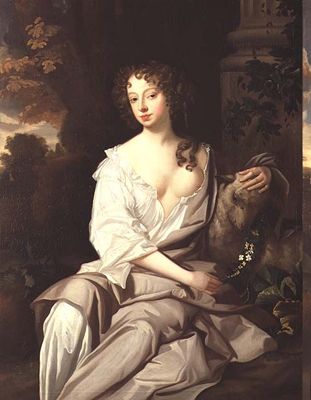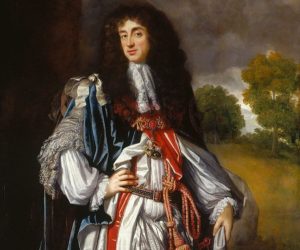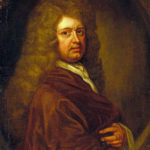CoHo’s Artistic Fellow and Dramaturg Jessica Dart will share her creative research on Playhouse Creatures in weekly blog posts during the run, or the full pdf is available for download here: PlayhouseCreaturesEducation.pdf
[maxbutton id=”87″ text=”Playhouse Creatures Tickets” ]
The Actresses
While based in fact, the women represented in the play have been fictionalized or represent a composite of several different women. We get a glimpse of the women both backstage and onstage, helping us to understand both their public and private personas. Time has also been compressed, allowing DeAngelis to create a fictional 1669-1670 based on more than two decades of history.
Nell Gwynn
 Born in 1650, Nell Gwynn (right) made her first appearance on the stage at about age 16 and became one of the most famous actresses of the Restoration. She was a favored mistress of Charles II and eventually had two children with him. She was the “least greedy” of his mistresses, and Charles made sure that Nell was provided for throughout her life. Nell began as an “orange girl” selling citrus outside of the Drury Lane Theatre. This was a common occupation for lower-class, foul-mouthed women of the era who may also have served as prostitutes. After becoming an actress, she was known as “pretty, witty Nell” for her comic abilities, and her skill in employing quick, sharp responses to hecklers. Nell is often represented in paintings with one breast bared and her arm draped over a lamb, allowing her to be at once erotic and innocent.
Born in 1650, Nell Gwynn (right) made her first appearance on the stage at about age 16 and became one of the most famous actresses of the Restoration. She was a favored mistress of Charles II and eventually had two children with him. She was the “least greedy” of his mistresses, and Charles made sure that Nell was provided for throughout her life. Nell began as an “orange girl” selling citrus outside of the Drury Lane Theatre. This was a common occupation for lower-class, foul-mouthed women of the era who may also have served as prostitutes. After becoming an actress, she was known as “pretty, witty Nell” for her comic abilities, and her skill in employing quick, sharp responses to hecklers. Nell is often represented in paintings with one breast bared and her arm draped over a lamb, allowing her to be at once erotic and innocent.
Mrs. Betterton
Mary Saunderson (left) married actor  Thomas Betterton in 1662, and the couple appeared onstage together frequently. She was best known for her performance as Ophelia opposite Mr. Betterton’s Hamlet, and for her brilliant portrayal of Lady Macbeth. Her specialty was tragedy and playing pure heroines, and according to The First English Actresses, she “never spoke a suggestive prologue in her life, yet on occasion she did play a lustful villainess.” Pepys refers to her affectionately as “Ianthe” in his diaries. The Bettertons had no children of their own, but often fostered and trained promising young actresses in their home. Mary was instrumental in teaching them proper technique and stage presence even after retiring from the stage.
Thomas Betterton in 1662, and the couple appeared onstage together frequently. She was best known for her performance as Ophelia opposite Mr. Betterton’s Hamlet, and for her brilliant portrayal of Lady Macbeth. Her specialty was tragedy and playing pure heroines, and according to The First English Actresses, she “never spoke a suggestive prologue in her life, yet on occasion she did play a lustful villainess.” Pepys refers to her affectionately as “Ianthe” in his diaries. The Bettertons had no children of their own, but often fostered and trained promising young actresses in their home. Mary was instrumental in teaching them proper technique and stage presence even after retiring from the stage.
Mrs. Marshall
Rebecca Marshall’s significant talent is mentioned several times in Pepys’ diaries. She took on formidable roles to much acclaim throughout her career, and she was one of the first actresses to leave for the Duke’s Company when the King’s Company began to have financial difficulties. Mrs. Marshall often found herself vulnerable to the cruelty of men who felt entitled to her body due to her actress status. She once claimed the King would protect her from Sir Hugh Middleton, but in retaliation Middleton employed a “Ruffian” to attack her on her way home from the theatre. On another occasion, she sought protection against a man who violently assaulted her in a coach and chased her with a sword. In the play she is in a tumultuous relationship with the Earl of Oxford (See Earl of Oxford entry below).
Mrs. Farley
Elizabeth Farley began her career as Mrs. Farley, but later married and changed her name to Mrs. Weaver. Although, some evidence suggests that she never actually married Mr. Weaver, just used his name. Scandal ensued when she became pregnant and word spread that their union wasn’t legal. As suggested in the play, Mrs. Farley was possibly an early mistress of Charles II, ca. 1661. Sadly, information about Mrs. Farley seems to center on the men with whom she associated as opposed to her own accomplishments and personality.
Doll Common
Mrs. Katherine Corey was among the first actresses on the Restoration stage, and the very first actress contracted by Killigrew for the King’s Company. Mrs. Corey was known for being “large and plain,” allowing her to play many character roles. Samuel Pepys dubbed Mrs. Corey “Doll Common” after seeing her in that role in Ben Jonson’s The Alchemist, and refers to her as such throughout his diaries. Doll’s character in Playhouse Creatures is not based directly on Mrs. Corey’s life/experience, but rather on the meaning of the name itself: Doll (short for Dorothy), and Common (implying commonness, simplicity, and perhaps looseness of morals).
The Men
Though there are no male characters physically present in the play, men influence, control, and complicate every facet of the women’s lives.
 King Charles II
King Charles II
Known for his dark curly hair, handsome face, and sexual appetite. Charles had many mistresses (several actresses among them). His relationship with Nell Gwynn resulted in two children and established Nell as a kind of rags-to-riches folk heroine.
From The Gay King: Charles II, His Court and Times by Dorothy Senior:
The man was a mass of contradictions. He was called the Merry Monarch and had the saddest face in the kingdom. He squandered thousands on his mistresses, yet grudged losing five pounds at tennis. He told Burnet that he looked upon falsehood and cruelty as the greatest crimes in God’s sight, and to his sister the Duchess of Orleans he wrote, “I am one of those Bigotts who thinke that malice is a much greater sinn than a poor frailty of nature.” Strange words these from one who sold his country to obtain pocket money and who had a man’s nose split to the bone as a reward for his too plain speaking.
Thomas Betterton

A prominent and talented actor/manager during the Restoration. He married Mary Saunderson (Mrs. Betterton) in 1662, and appeared onstage with her often. He is/was considered by many to be the greatest actor of all time, and a champion of women on the stage. Betterton is buried in Westminster Abbey. Strangely, Betterton’s average looks did not stop him from playing young, dashing, and heroic roles throughout his career.
The Earl of Oxford
 Mentioned in the play as the man who torments Mrs. Marshall. This story is based on Aubrey de Vere’s (the Earl of Oxford) deception of actress Hester Davenport. The Earl fell in love with Mrs. Davenport while she was playing the role of Roxalana in The Siege of Rhodes, and
Mentioned in the play as the man who torments Mrs. Marshall. This story is based on Aubrey de Vere’s (the Earl of Oxford) deception of actress Hester Davenport. The Earl fell in love with Mrs. Davenport while she was playing the role of Roxalana in The Siege of Rhodes, and
attempted to woo her by sending gifts and messages to the playhouse. Mrs. Davenport refused his advances and returned his presents. Finally de Vere promised to marry her, and Mrs. Davenport accepted. See the play to find out what happened next!




